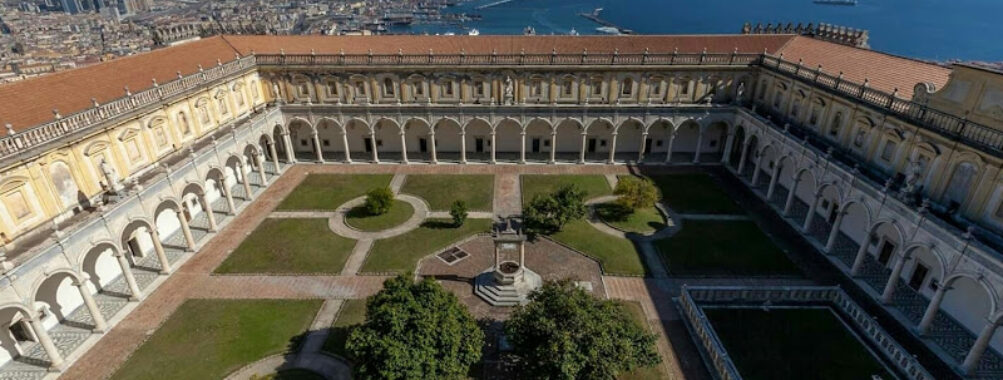
Certosa e Museo di San Martino
Table of Contents
Description
Overlooking the Bay of Naples from its majestic perch on Vomero hill, the [Certosa e Museo di San Martino](https://www.tripadvisor.com/Attraction_Review-g187785-d195426-Reviews-Certosa_E_Museo_Di_San_Martino_Napoli-Naples_Province_of_Naples_Campania.html) stands as one of Naples’ most impressive cultural treasures. Originally established as a [Carthusian monastery in the 14th century](https://travel.usnews.com/Naples_Italy/Things_To_Do/Certosa_e_Museo_di_San_Martino_63627/), this architectural marvel has evolved into a spectacular museum that showcases the rich artistic heritage of Naples.
The complex is anchored by its stunning baroque church, where your jaw will definitely drop at the sight of those magnificent ceiling frescoes – I still remember gasping out loud when I first looked up! The centerpiece is the breathtaking [Ascension painted by Lanfranco](https://www.tripadvisor.com/Attraction_Review-g187785-d195426-Reviews-Certosa_E_Museo_Di_San_Martino_Napoli-Naples_Province_of_Naples_Campania.html), which seems to defy the laws of perspective. And don’t even get me started on that gleaming marble altar – it’s a masterpiece of baroque craftsmanship that’ll have you reaching for your camera.
[Since 1866, it’s served as a museum](https://www.naplespass.eu/attractions/certosa-e-museo-di-san-martino) dedicated to preserving and displaying Naples’ artistic and cultural heritage. What really makes this place special is how it manages to be both a sacred space and a treasure house of art. You’ll find yourself wandering through what many consider (https://www.lonelyplanet.com/italy/campania/naples/attractions/certosa-e-museo-di-san-martino/a/poi-sig/422533/359879), where the peaceful atmosphere of the former monastery still lingers.
Key Features
• The Great Cloister with its marble columns and stunning garden
• Baroque church featuring Lanfranco’s ceiling masterpiece
• Naval Gallery showcasing historical maritime exhibits
• Quarto del Priore with its decorated halls
• Collection of Neapolitan Nativity scenes (presepi)
• Picture Gallery with works from renowned artists
• The Courtyard of the Procurers
• Panoramic terraces offering sweeping views of Naples
• Historical carriages collection
• Decorative arts section featuring porcelain and textiles
Best Time to Visit
Early morning is your best bet to explore this gem without the crowds. I’ve found that weekday mornings, particularly Tuesday through Thursday, offer the most peaceful experience. Avoid weekends if possible – that’s when local families and tourist groups tend to flood in. The light is particularly magical during the golden hour, just after opening time, when it streams through the church windows and makes those frescoes practically glow.
Spring (April-May) and fall (September-October) are ideal seasons to visit, mainly because you can fully enjoy the outdoor spaces and terraces without melting in the summer heat or getting caught in winter rains. Plus, the gardens are absolutely gorgeous during these months – the perfect backdrop for those Instagram-worthy shots!
How to Get There
Getting to San Martino is actually part of the adventure! The easiest way is taking the Centrale funicular to Piazzetta Fuga and then walking about 10 minutes uphill. Yeah, it’s a bit of a climb, but trust me – those views are worth every step! If you’re not feeling the walk, grab the C31 bus from Vanvitelli station.
For those who prefer a more scenic route, you can take the Montesanto funicular to Morghen station and enjoy a lovely stroll through the Vomero neighborhood. Just follow the signs – they’re pretty clear, and locals are always happy to point you in the right direction if you get turned around.
Tips for Visiting
Okay, let me share some insider tips that’ll make your visit way smoother. First off, wear comfortable shoes – those marble floors are stunning but slippery! And the whole complex is pretty huge, so you’ll be doing lots of walking.
Budget at least 2-3 hours for your visit – there’s so much to see, and you’ll kick yourself if you have to rush through. Bring a water bottle and maybe a snack since there’s no restaurant on site. The lighting can be tricky for photos, so if you’re into photography, pack a camera that handles low light well.
The museum gets really quiet around lunchtime (1-3 PM), making it perfect for those seeking a more contemplative experience. And don’t skip the terraces – some visitors miss them, but they offer some of the best views in Naples. I always tell people to save them for last; it’s like a reward after exploring all the art and history inside.
Oh, and here’s a pro tip: grab one of the audio guides. They’re not expensive and totally worth it – there’s so much history and detail you might miss otherwise. And while the main attractions are amazing, don’t forget to peek into the smaller rooms and corridors. Some of the most interesting pieces are tucked away in corners where most tourists don’t bother looking.
Keep in mind that some sections might be closed for restoration without notice – it’s an old building that needs constant care. But honestly? That’s part of its charm. Every visit feels a little different, and you always discover something new.
Location
Places to Stay Near Certosa e Museo di San Martino
Find and Book a Tour
Explore More Travel Guides
No reviews found! Be the first to review!